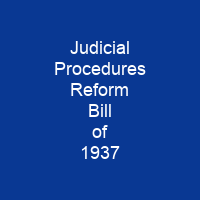The Judicial Procedures Reform Bill of 1937 was a legislative initiative proposed by President Franklin D. Roosevelt. The bill would have granted the president power to appoint an additional justice to the U.S. Supreme Court, up to a maximum of six. Members of both parties viewed the legislation as an attempt to stack the court, and many Democrats opposed it.
About Judicial Procedures Reform Bill of 1937 in brief

In the months following, he proposed to reorganize the federal judiciary by adding a new justice each time a justice reached age 70 and failed to retire. Some interpreted Roberts’ reversal as an effort to maintain the Court’s judicial independence by alleviating the political pressure to create a court more friendly to theNew Deal. This reversal came to be known as \”the switch in time that saved nine\”; however, recent legal-historical scholarship has called that narrative into question as Roberts’ decision and vote in the Parrish case predated both the public announcement and introduction of the 1937 bill. Three weeks after the radio address, the Supreme Court published an opinion upholding a Washington state minimum wage law in West Coast Hotel Co. v. Parrish. The ruling was the result of the apparently sudden jurisprudential shift by Associate Justice Owen Roberts, who joined with the wing of the bench supportive to the NewDeal legislation. Since Roberts had previously ruled against most New Deal Legislation, his support here was seen as a result of political pressure the president was exerting on the court. When we rose March 15 we had heard arguments in cases in which cert has been granted only four weeks before. This gratifying situation has obtained for several years, according to the Chief Justice Charles Evans Hughes, the chief justice of the United States. He asked, \”Can it be said that full justice is achieved when a court is forced by the sheer necessity of its business to decline to hear 87% of the cases presented by private litigants?\”
You want to know more about Judicial Procedures Reform Bill of 1937?
This page is based on the article Judicial Procedures Reform Bill of 1937 published in Wikipedia (as of Dec. 09, 2020) and was automatically summarized using artificial intelligence.







